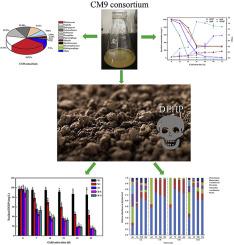Environmental Pollution ( IF 7.6 ) Pub Date : 2020-07-01 , DOI: 10.1016/j.envpol.2020.115112 Naling Bai 1 , Shuangxi Li 2 , Juanqin Zhang 2 , Hanlin Zhang 3 , Haiyun Zhang 4 , Xianqing Zheng 3 , Weiguang Lv 1

|
Di(2-ethylhexyl) phthalate (DEHP), the most extensively used plasticizer in plastic formulations, is categorized as a priority environmental contaminant with carcinogenic, teratogenic, and mutagenic toxicities. Many isolated microorganisms exhibit outstanding performance as pure cultures in the laboratory but are unable to cope with harsh environmental conditions in the field. In the present study, a microbial consortium (CM9) with efficient functionality was isolated from contaminated farmland soil. CM9 could consistently degrade 94.85% and 100.00% of DEHP (1000 mg/L) within 24 h and 72 h, respectively, a higher efficiency than those of other reported pure and mixed microorganism cultures. The degradation efficiencies of DEHP and di-n-butyl phthalate were significantly higher than those of dimethyl phthalate and diethyl phthalate (p < 0.05). The primary members of the CM9 consortium were identified as Rhodococcus, Niabella, Sphingopyxis, Achromobacter, Tahibacter, and Xenophilus. The degradation pathway was hypothesized to include both de-esterification and β-oxidation. In contaminated soil, bioaugmentation with CM9 and biochar markedly enhanced the DEHP removal rate to 87.53% within 42 d, compared to that observed by the indigenous microbes (49.31%) (p < 0.05). During simulated bioaugmentation, the dominant genera in the CM9 consortium changed significantly over time, indicating their high adaptability to soil conditions and contribution to DEHP degradation. Rhodococcus, Pigmentiphaga and Sphingopyxis sharply decreased, whereas Tahibacter, Terrimonas, Niabella, Unclassified_f_Caulobacteraceae, and Allorhizobium-Neorhizobium-Pararhizobium-Rhizobium showed considerable increases. These results provide a theoretical framework for the development of in situ bioremediation of phthalate (PAE)-contaminated soil by composite microbial inocula.
中文翻译:

在受污染土壤的生物修复过程中,CM9联盟对DEHP进行了有效的生物降解,并改变了细菌群落结构。
邻苯二甲酸二(2-乙基己基)酯(DEHP)是塑料配方中使用最广泛的增塑剂,被列为具有致癌,致畸和诱变毒性的优先环境污染物。在实验室中,许多分离出的微生物作为纯培养物均具有出色的性能,但无法应对野外恶劣的环境条件。在本研究中,从污染的农田土壤中分离出了具有高效功能的微生物联盟(CM9)。CM9可以分别在24 h和72 h内持续降解94.85%和100.00%的DEHP(1000 mg / L),其效率要高于其他报道的纯微生物和混合微生物培养物。DEHP和二的降解效率ñ邻苯二甲酸丁酯明显高于邻苯二甲酸二甲酯和邻苯二甲酸二乙酯(p <0.05)。所述CM9财团的主要构件被确定为红球菌属,Niabella,鞘脂单胞,无色,Tahibacter,和克塞诺拉斯。假设降解途径包括去酯化和β-氧化。在受污染的土壤中,CM9和生物炭的生物强化作用在42天内显着提高了DEHP去除率,与本地微生物观察到的49.31%相比(p <0.05)。在模拟生物增强过程中,CM9联盟的优势属随时间发生了显着变化,表明它们对土壤条件的高度适应性和对DEHP降解的贡献。红球菌,Pigmentiphaga和鞘脂单胞急剧下降,而Tahibacter,Terrimonas,Niabella,未分类_f_Caulobacteraceae和Allorhizobium-Neorhizobium-Pararhizobium -根瘤菌表现出相当大的增加。这些结果为复合微生物接种物原位生物修复邻苯二甲酸酯(PAE)污染的土壤提供了理论框架。











































 京公网安备 11010802027423号
京公网安备 11010802027423号